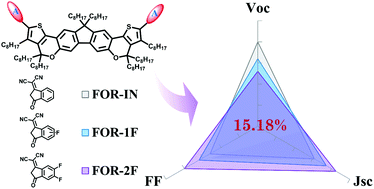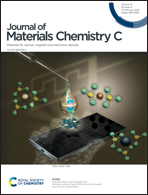Molecular optimization of incorporating pyran fused acceptor–donor–acceptor type acceptors enables over 15% efficiency in organic solar cells†
Abstract
A series of acceptor–donor–acceptor type fused-ring non-fullerene acceptors, FOR-IN, FOR-1F and FOR-2F, were designed and synthesized, featuring the same pyran-composed backbone and different fluorine-substituted 1,1-dicyanomethylene-3-indanone terminals. The increased fluorine substitution in FOR-2F enhances its light harvesting capacity and electron mobility significantly, compared with the molecules FOR-IN and FOR-1F. With FOR-2F as the acceptor and the matching polymeric PM6 as the donor, their organic solar cells demonstrate a high performance of up to 15.18% power conversion efficiency. This is the highest performance reported to date for all pyran fused NFAs. In addition, the fluorine number- and location-induced variations of electronic property, charge transport, film morphology and photovoltaic property were investigated systematically.

- This article is part of the themed collection: Journal of Materials Chemistry C HOT Papers


 Please wait while we load your content...
Please wait while we load your content...